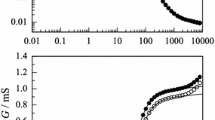Abstract
Dipole moments of the fluorescent probes 1-phenylnaphthylamine (1-AN) and 1-anilinonaphthalene-8-sulfonate (1,8-ANS) are measured using electro-optical absorption and emission methods. Dipole moments in the ground and excited states were measured in cyclohexane and dioxane. It is shown that the charge distributions in the 1-AN and 1,8-ANS molecules differ substantially. The spectral dependence of the electro-optical coefficients suggests that the absorption spectrum of 1,8-ANS is due to a superposition of (at least two) electronic transitions. It is found that spectra of 1-AN in erythocyte ghosts are inhomogeneously broadened. The above effect makes it possible to selectively excite probe molecules localized at different sites of a membrane. Dielectric interactions (described by the local dielectric constant) are investigated in human erythrocyte membranes. It is found that the dielectric constant of erythrocyte membranes varies from 6.79 ±0.8 to 17.6±3.5 depending on the excitation frequency and, therefore, on the localization of the probe.
Similar content being viewed by others
References
Yu. A. Vladimirov and G. E. Dobretsov,Fluorescent Probes in the Study of Biological Membranes [in Russian], Moscow (1980).
W. Liptay, in: E. C. Lim (ed.),Excited States, Vol. 1, New York (1974), pp. 129–229.
W. Baumann, in: B. W. Rossiter and J. F. Hamilton (eds.),Physical Methods of Chemistry, Vol. 3B, Chichester (1989), pp. 45–131.
W. Rettig and W. Baumann, in: J. F. Rabek (ed.),Progress in Photochemistry and Photophysics, Vol. 6, Boca Raton (1992), pp. 79–134.
N. A. Nemkovich, W. Baumann, H. Reis, and N. Detzer,J. Photochem. Photobiol. A: Chem.,89, 127–133 (1995).
N. A. Nemkovich, W. Baumann, and H. Reis,Zh. Prikl. Spektrosk.,62, 229–239 (1995).
N. A. Nemkovich, W. Baumann, H. Reis, and A. S. Kozlovsky,Proc. SPIE,2388, 335–346 (1995).
N. A. Nemkovich, W. Baumann, H. Reis, and Yu. V. Zvinevich,Proc. SPIE,2980, 390–399 (1997).
N. A. Nemkovich, H. Reis, and W. Baumann,J. Lumin,71, 255–263 (1997).
N. A. Nemkovich, W. Baumann, H. Reis, and Yu. V. Zvinevich,J. Photochem. Photobiol. A: Chem.,109, 287–292 (1997).
M. Kumbar and V. T. MaddaiahBiochim. Biophys. Acta,497, 707–718 (1977).
J. C. Smith and R. W. Woody,J. Phys. Chem.,80, 1094–1100 (1976).
E. Kosower and H. Dodiuk,Chem. Phys. Lett.,26, 545–548 (1974).
E. Kosower, H. Dodiuk, K. Tanizawa, M. Ottolenghi, and N. Orbach,J. Am. Chem. Soc.,97, 2167–2178 (1975).
Y.-H. Li, L.-M. Chan, L. Tyer, R. T. Moody, C. M. Himel, and D. M. Hercules,J. Am. Chem. Soc.,97, 3118–3126 (1975).
D. M. Gakamsky, A. P. Demchenko, N. A. Nemkovich, et al.,Biophys. Chem.,42, 49–51 (1992).
N. A. Nemkovich,Proc. SPIE,1922, 209–218 (1992).
N. A. Nemkovich and A. N. Rubinov,J. Fluoresc.,5, 285–294 (1995).
N. A. Nemkovich, A. N. Rubinov, and V. I. Tomin, in: J. R. Lahowicz (ed.)Topics in Fluorescence Spectroscopy, Vol. 2: Principles, New York (1991), pp. 267–428.
J. T. Dodge, C. Mitchell, and D. J. Hanahan,Arch. Biochem. Biophys,100, 119–130 (1963).
A. Kawski and B. Pasztor,Acta Phys. Polon.,29, 187–193 (1966).
D. Toptygin and L. Brand,Biophys. Chem.,48, 205–220 (1993).
Author information
Authors and Affiliations
Additional information
Translated from Zhurnal Prikladnoi Spektroskopii, Vol. 66, No. 3, pp. 387–393, May–June, 1999.
Rights and permissions
About this article
Cite this article
Nemkovich, N.A., Baumann, W., Kruchenok, Y.V. et al. Use of the red-edge excitation effect for investigation of dielectric interactions in biomembranes. J Appl Spectrosc 66, 415–422 (1999). https://doi.org/10.1007/BF02676774
Received:
Issue Date:
DOI: https://doi.org/10.1007/BF02676774




